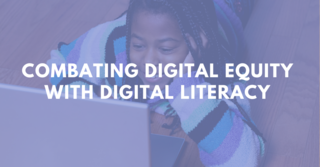Education
Why It’s Time to Rethink Digital Citizenship Education
Digital equity means supporting all students to use tech responsibly.
Posted May 25, 2021 Reviewed by Devon Frye
In a March interview with the website PatientEngagementHIT, Gina Altieri, the executive vice president and enterprise chief communications officer of Nemours Children’s Health, said that the hospital saw that the pandemic’s “digital divide” impacted their patient families in two ways:
- those without devices or adequate infrastructure support, like broadband
- those without the digital health literacy necessary to engage supportively with virtual tools
As a clinical psychologist who researches digital technologies to support adolescent health, the latter concerns me most. Why? Education problems aren’t as easy to solve and current support for curricular focus on evaluating digital content is quite thin. An exorbitant amount of attention and tangible resources like laptops and free Internet programs have been allocated to students and families during the pandemic, but what happens when those parents and children don’t know how to use or access them in a way that helps them to thrive?
A review of literature in the journal Sociological Inquiry found that even when we control basic Internet connectivity issues, systematic differences still exist along lines of race, class, and gender. And a 2014 study found, not surprisingly, that students from low-income families didn’t have equal instruction in online reading, reasoning, and discourse (i.e., ability to find, evaluate, integrate, and communicate online information) compared to students from more affluent families. Why?
At its core, this is the very definition of digital equity: ensuring students have equal access to technology—as well as the training necessary to navigate digital tools.

Combating Digital Equity with Digital Literacy
Dr. Brendesha Tynes, professor of Education and Psychology at the University of California Rossier School of Education (and a researcher I greatly admire), is currently leading a first-of-its-kind, nationally representative, longitudinal online survey of 11- to 19-year-olds’ critical digital literacy skills—which includes their ability to critique race-related material. She aims to answer the following questions:
- Can youth adequately critique the negative race-related messages they receive online?
- What factors might allow them to better evaluate and counter these messages?
- Could these skills potentially buffer them against negative mental health, behavioral, and academic outcomes?
Given the increasing spread of misinformation on social media and the rise of mental health issues affecting people of all ages, Dr. Tynes’ findings will be invaluable in developing evidence-based and developmentally and culturally appropriate materials to build digital citizenship in post-pandemic America. (And I recommend reading her chapter “Rethinking Digital Citizenship” within "Educating for Civic Reasoning & Discourse," a research report published by the National Academy of Education).

Digital Citizenship Is Not Limited to Online Safety Skills
Twelve years ago, NPR did a story with the headline “Schools Urged to Teach Digital Citizenship.” Clearly, a lot has changed since then. As we shift the conversation in this country from one of fear and negativity to one of inclusivity, empathy, and action, here are five core competencies of digital citizenship compiled by DigCitCommit, a coalition of organizations that aim to teach digital citizenship. See how you can incorporate them into your 2021-2022 school curriculum and/or reinforce them in your own home this summer.
Inclusive: I am open to hearing and respectfully recognizing multiple viewpoints and I engage with others online with respect and empathy.
So much of Gen Zers’ learning and development is done online where they are faced with a barrage of race-related material and opinions and experiences of those that may or may not be different from where they live, learn, or play. In Stamped from the Beginning, for example, Africana Studies scholar Ibram X. Kendi argues that an education in “anti-racist ideas” from a young age would give children the perspective and understanding necessary for consuming later lessons in the social sciences and humanities. The same can be said about the inclusion of neurodiverse perspectives and those of the LGBTQ+ community.
Informed: I evaluate the accuracy, perspective, and validity of digital media and social posts.
In 2017, a survey of 15-27-year-olds found students who reported having media literacy learning opportunities were better at rating the accuracy of posts containing political arguments and evidence. Right now, most Americans could probably use some improvement in this area. The spread of misinformation is so pervasive. Teaching young people the importance of citing their original sources of information or even tagging them on social media is an easy way to plant the seed.
Engaged: I use technology and digital channels for civic engagement, to solve problems and be a force for good in both physical and virtual communities.
There are so many examples of youth who #DoGoodDigital. They raise awareness and advocate for causes that matter to them vs. mindlessly scrolling their social feeds. In my last post, I discussed a tech strategy for balancing quality over quantity. In the context of digital citizenship education, it’s helpful to view our screen-time as an opportunity for authentic learning that supports genuine connections.
Balanced: I make informed decisions about how to prioritize my time and activities online and off.
It’s natural to think one would need a screen to learn lessons grounded in digital citizenship. I’m here to tell you that’s not necessarily true. Researchers at Brown University found students involved in the #NeverAgain movement against gun violence acquired the skills to lead through extracurriculars such as debate, newspaper, student government, and drama clubs. There is value to being involved. Too much video game play takes kids away from other valuable activities for their social, emotional, and creative development.
Alert: I am aware of my online actions and know how to be safe and create safe spaces for others online.
One word: cyberbullying. The need to provide students with strategies to monitor their own and others’ emotions as they interact with technology has never been greater. Before commenting, remind kids to consider how they would feel if someone else said the same thing to or about them. If something needs reported (i.e., suicide threats, bullying, violence, etc.) make sure students know who the "authorities" are in that context. Reporting it is good digital citizenship, and I personally was happy to read TikTok has introduced new features to curb cyberbullying.
If you made it through this far and found it either informative or inspiring (hopefully both), go ahead and share it on your social media with a comment about something that resonated most with you. Your perspective matters and your friends’ perspectives matter.
References
Hargittai, E. (2010). Digital na(t)ives? Variation in Internet skills and uses among members of the “Net Generation.” Sociological Inquiry, 80(1), 92–113.
Jenkins, H., & Lopez, R. A. (2018). On Emma Gonzalez’s jacket and other media: The participatory politics of the #NeverAgain movement. Brown Journal of World Affairs, 25, 117.
Kahne, J., & Bowyer, B. T. (2017). Educating for democracy in a partisan age: Confronting the challenges of motivated reasoning and misinformation. American Educational Research Journal, 54(1), 3–34.
Kendi, I. X. (2016). Stamped from the beginning: The definitive history of racist ideas in America. Nation Books.
Leu, D. J., Forzani, E., Rhoads, C., Maykel, C., Kennedy, C., & Timbrell, N. (2014). The new literacies
of online reading and comprehension: Rethinking the reading achievement gap. Reading Research
Quarterly, 50(1), 37–59.




